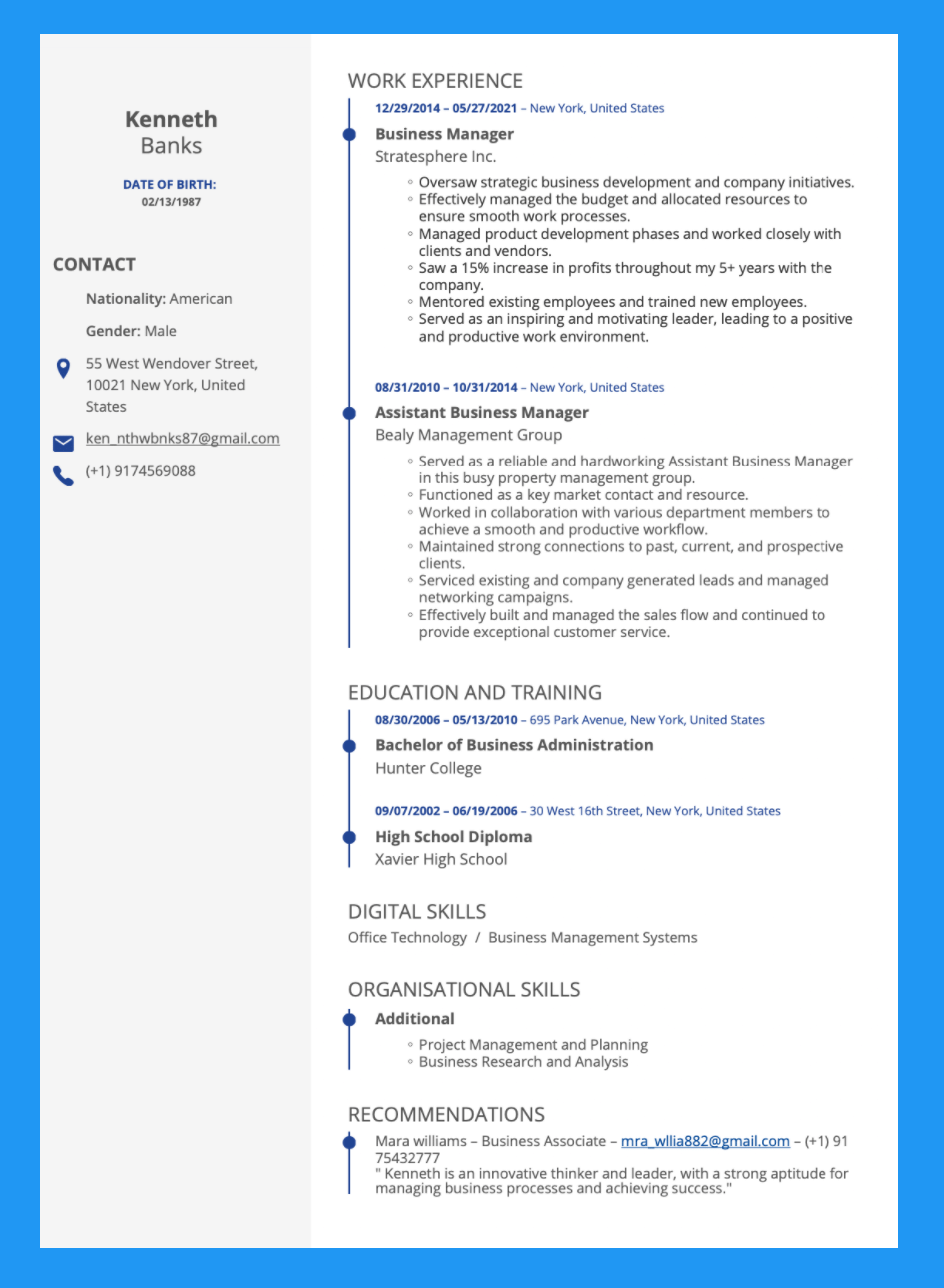It can feel intimidating to apply for jobs in another country where you don’t know the standard practices and norms. If you’re moving to Europe, however, there is a helpful tool you can use to prepare your European resume: the Europass CV (curriculum vitae).
This standardized resume template offers a simple way to describe your skills, experience, and qualifications to European employers. This article will discuss the pros and cons of the Europass CV and show you how to create one.
What is the Europass CV?
The Europass CV is a standardized resume format developed by the European Union. You can create a Europass CV by registering online and filling out information about your skills, work history, and education. Once you have a profile, you can create multiple versions of your resume. You can also share it with employers in different languages.
The purpose of the Europass CV is to offer a standard format for candidates to apply for jobs in Europe. It’s a widely recognized international CV format in many countries, offering a clear way for job applicants to describe their skills and qualifications.
Europass CV format & example

Like many other resume templates, the Europass CV has separate sections for your work history, education, and personal skills. It’s a simple, no-frills resume format that displays your professional credentials in an organized manner.
Here are the key sections of the Europass CV format:
- Personal information. In this section, you’ll provide your full name, email, physical address, and phone number. You can also add a photo of yourself.
- Work history. This section displays your employment history in reverse chronological order, starting with your most recent position. Use short sentences or bullet points to describe your job duties and achievements.
- Education and training. This section should list your formal education, such as a degree. It can also include information about informal education, such as a certification course.
- Skills. The standard Europass CV template includes sections for your languages and other hard skills. You should specify your native language and all the other languages you speak. You’ll also include any technical, organizational, managerial, communication, and other job-related skills and how you acquired them.
- Additional sections. Beyond these standard sections, you can also add other helpful information to your Europass CV. Some examples of additional sections include honors and awards, hobbies and interests, publications, networks and memberships, and volunteering.
Europass CV example template
While you can create a Europass CV online, you can also use this template to make a similar version:
Personal Information
[First Name] [Surname]
[Address], [Phone number], [Email]
Work Experience
[Position held]
[Employer’s name and location], [Dates of employment]
- [Main activity or responsibility]
- [Main activity or responsibility]
- [Main activity or responsibility]
Education and Training
[Qualification awarded]
[Name of educational institution and location], [Dates of completion]
- [Subject covered or skill acquired]
- [Subject covered or skill acquired]
- [Subject covered or skill acquired]
Languages
[Mother tongue]
[Other language(s) with proficiency]
Personals Skills
[Skill 1], [Skill 2], [Skill 3]
Differences between Europass & regular CV
While the Europass CV shares many elements with a traditional resume or CV, there are also some key differences to know. The most notable differences include the following:
| FEATURE: | EUROPASS CV: | REGULAR CV: |
| Structure | Standardized, fixed format | Flexible, customizable layout |
| Usage | Recognized across Europe | Varies by country or employer |
| Customization | Limited customization options | Highly customizable |
| Design | Plain and text-heavy | Allows for creative, modern designs |
| Flexibility | Standard sections with limited options | Flexible sections |
| Length | Two or more pages | One to two pages |
| Photo | Common to include | Usually discouraged |
- Structure. The Europass CV has a fixed structure, so all CVs with this format look similar. A traditional resume or CV generally has a flexible layout that you can customize based on your preferences.
- Usage. Employers across the European Union, regardless of country, recognize the Europass CV format. In contrast, the usage of traditional resumes can vary by country or employer.
- Customization. You have limited options to customize a Europass CV. With a regular resume, you have nearly endless customization and formatting options.
- Design. The Europass CV offers a simple, text-heavy design to keep the focus on applicants’ qualifications. For a more modern, eye-catching resume, try an ai resume writer that can help you create a personalized and creative design tailored to your industry and country.
- Flexibility. With the Europass CV, you’re confined to specific sections about your work history, skills, and education. A traditional resume offers more flexibility in the sections you can add. With a regular resume, you can also include a professional summary, which isn’t a standard section on a Europass CV.
- Length. You can add many details to a Europass CV, so it’s often two pages or longer. In comparison, a traditional resume is usually one to two pages maximum.
- Photo. It’s common to include a photo on a Europass CV. With traditional resumes, it’s usually discouraged to have a photo of yourself.
As you can see, a traditional resume or CV offers more options for customization, design, and flexibility. If you’re intimidated by the idea of creating a resume from scratch, use our intuitive Resume Builder to create a fully customized, professional resume in just minutes!
Here’s an example of a resume created with our easy-to-use Resume Builder:
How to create a Europass CV
Applying for jobs in Europe? Follow these steps to create a European CV:
Step 1. Create a profile
Start by creating a Europass profile. Once you have a profile, you can edit and save your information whenever you want.
Step 2. Add your information
Next, complete the steps to add your information to your profile. You will need to provide your personal contact information, work experience, education and training, languages, and skills. You can leave any field blank, but it’s in your best interest to provide as much detail as you can.
Once you’ve filled out your profile, you can also choose to add a profile in another language. Use this option if you speak multiple languages or if you’re applying for jobs in a country that speaks another language.
Step 3. Choose a template
After completing your profile, you can create your CV. Choose a template from the preexisting options. For each template, you can customize the color and text size. You can also add page numbers.
Step 4. Download or save
Preview your CV and make sure it looks the way you want. Once you’re satisfied with your European CV, you can download the document or save it to your library. If you plan to create multiple versions, choose a different name for each one so that you can easily find it later.
Pros and cons of using a Europass CV
Like all resume templates, the Europass CV has its pros and cons. It’s free to use and offers a standard format for candidates who want to apply for jobs in Europe. It’s a good option if you’re applying for international jobs because it’s recognized by employers in many different countries.
However, there are also some downsides to the Europass CV. Consider these disadvantages if you plan to use this format:
- Unattractive design. Some people criticize the Europass CV for having an outdated, unattractive design.
- Frustrating interface. The Europass CV online generator has some glitches, and the platform can be confusing to navigate, especially for first-time users.
- Standardized template. The Europass CV’s main purpose—providing a standardized template for job seekers—is also one of its downfalls. With many people using this template, it’s hard to set your resume apart from other applicants.
Europass CV FAQs
Review these answers to other frequently asked questions about the Europass CV:
Is the Europass CV free?
Yes, it’s free to create a Europass profile and build, download, and share your CV.
Can Americans (and non-Europeans) use the Europass CV?
Yes, anyone can use the Europass CV. In fact, the template’s standard format makes it a good choice for people looking to move abroad who are unfamiliar with resume practices in other countries.
Is the Europass CV worth it?
That depends on several factors, including your personal preferences, level of experience, and industry. If you’re just beginning your career, the Europass CV offers an easy way to create a resume for your first job.
However, if you’re a mid-career professional or if you work in a creative field, there are probably better options for your resume template.
Does a Europass CV need a photo?
No, you don’t need to have a photo on your Europass CV, although it’s an option if you decide that you want to include it.
Is the Europass CV outdated?
Some people consider the Europass CV format and design to be outdated. However, it is still widely recognized across employers in Europe.





